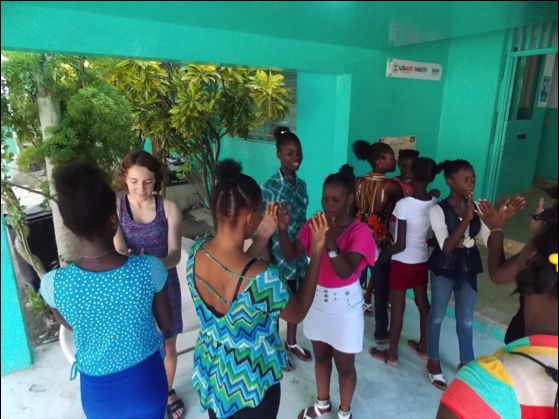Girls’ Day Festivities Briefly Eclipse Cultural Divide

On a bright Sunday afternoon in Borgne, Haiti, 12 bright girls aged 12-15 came together to celebrate the United Nations’ International Day of the Girl Child. One had traveled from San Francisco, the others live in town or close by, and a few of them attend the same school. Although clearly curious about each other, at first no one wanted to be the first to talk. Introductions helped to break the ice, and one girl from Borgne, sporting the brightest eyes and smile, jumped in, starting a vibrant conversation that traversed geographic, cultural and class boundaries.
The girls from Borgne were very curious about their new San Franciscan friend, who had come to Borgne, in part, to learn more about daily life for girls there. After a tentative start, questions started gushing out. Safe questions such as, “What do you want to do when you grow up?” and “What’s your favorite subject” in school, quickly segued to these lively teens chattering about how and where they like to hang out with friends after school and comparing notes about homework and their daily chores. They empathized over annoying siblings and “boring stuff,” illustrating a universality to adolescent girls that transcends borders.
This impromptu gathering, organized by WSI Consortium member Haiti Outreach – Pwoje Espwa (H.O.P.E.)’s S.E.E.-Fanm project, was part of WomenStrong International’s broader celebration of girls worldwide. In fact, two of the most active participants in this informal cultural exchange, Gania and Islourde, are featured in our Girls’ Day coverage.
A sleepy small town along Haiti’s shimmering, impoverished northern coast, Borgne is very far removed from the hustle of Haiti’s capital, Port au Prince, even from the daunting challenges facing the largest city in Haiti’s north, Cap Haitien. The children of Borgne don’t usually see many visitors, except perhaps international medical workers, and they rarely have the chance to interact with them, certainly not with their peers from other countries. So everyone understood that this Day of the Girl was unusual, and no one wanted this special girls’ time to end.
Without speaking each others’ languages, though, there was little the girls could actually do together, without adults around, serving as translators and facilitators. But leave it to girls, to figure it out for themselves: at their own initiative, first two by two, then all together, they began playing games known all over the world — clapping hands in different patterns, upping the ante by upping the tempo, the number of repetitions and the inevitable eruptions of giggles into peals of laughter.
A lesson, from their time together? Maybe that girls from some of the richest and poorest nooks on our planet share similar dreams, worries, aggravations and delights and are so ready to come together, in sisterhood, solidarity, joy and in peace, despite the vastly differentiated circumstances of their lives.

